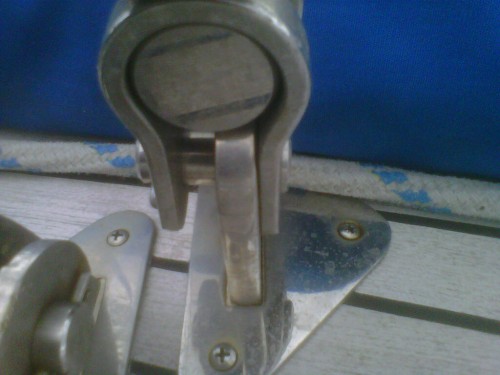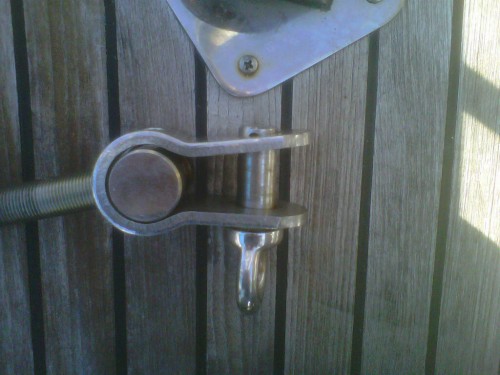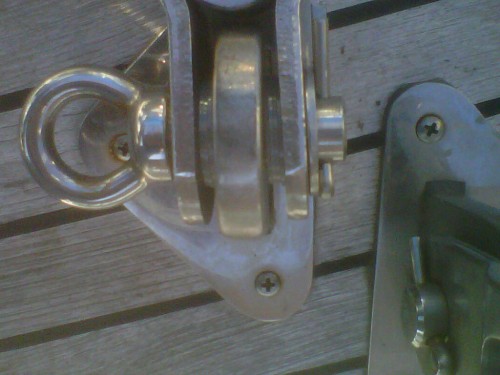Do you want to be informed on new Posts on this Thread? (members only)
| S&S Swan Maintenance - Rig Failure warning |
|---|
|
Join Date: 01 February 2007
Posts: 234 |
||
|---|---|---|
|
Rig Failure warning  Mis alignment of bottle screw  Clevis pin sprung open  Temporary fix |
|
Join Date: 08 May 2009
Posts: 7 |
||
|---|---|---|
|
Interesting. |
|
Join Date: 02 January 2008
Posts: 1547 |
||
|---|---|---|
|
Dear John
|
|
Join Date: 01 February 2007
Posts: 234 |
||
|---|---|---|
|
Lars, I agree that a bolted clevis pin is a stronger option. That will be one of this winters jobs.
|
|
Join Date: 02 January 2008
Posts: 1547 |
||
|---|---|---|
|
Dear John
|
|
Join Date: 01 February 2007
Posts: 234 |
||
|---|---|---|
|
Dear Lars, would you know the likely operating loads on the clevis pins so I can specify to riggers.
|
|
Join Date: 02 January 2008
Posts: 1547 |
||
|---|---|---|
|
Dear John
|
|
Join Date: 16 May 2009
Posts: 252 |
||
|---|---|---|
|
I recently had a failure of my D1. The split pin which locks the clevis pin in place snapped, causing the clevis pin to shoot out and the rig detach from the shroud plates. The initial cause appeared to be the bottle crew straps not being parallel. On investigation it can be seen that the straps are not sitting correctly on the shroud plates forcing them open, so putting pressure on the split pins. Further investigation showed that the shroud plates seem to have bent over time under load causing the lead from the rig to not align as designed. A temporary solution has been to pack the clevis pin with washers until later this year when the shroud plates can be removed and straightened. All 4 shrouds have the same problem. CHECK YOUR RIGS. John: |
|
Join Date: 02 January 2008
Posts: 1547 |
||
|---|---|---|
|
Dear Geoff
|
|
Join Date: 16 May 2009
Posts: 252 |
||
|---|---|---|
|
Dear Geoff If you mean the triangular deck plates around the chainplates, they are cosmetic, and not attached to the vertical lugs. Small screws suffice. Kind regards Lars Thanks Lars - then what ties the lug down structurally? Is it bolted into the knee with transverse bolting? |
|
Join Date: 01 February 2007
Posts: 234 |
||
|---|---|---|
|
Yes, tied with bolts. Its worth taking them out during a maintenance period and checking / re fitting etc. Take care to properly refit and use the correct Sika products to stop leaks.
|
|
Join Date: 16 May 2009
Posts: 252 |
||
|---|---|---|
|
Yes, tied with bolts. Its worth taking them out during a maintenance period and checking / re fitting etc. Take care to properly refit and use the correct Sika products to stop leaks. I will this winter straighten the shroud plates as recommended by Lars and get them checked for cracks etc. They are made from a single piece of stainless so no welds. John B Of course. I think I have seen posts with the bolting shown - I don't know how I could have thought those tiny screws held anything, but I am sure glad to know they don't. I know the previous owner stiffened the knees on my boat, I don't know if he changed out the bolts, but I am going to make sure. I have all good new standing rigging and want to know the foundation is solid. I appreciate this post in that regard very much - thanks again. |
|
Join Date: 16 May 2009
Posts: 252 |
||
|---|---|---|
|
Yes, tied with bolts. Its worth taking them out during a maintenance period and checking / re fitting etc. Take care to properly refit and use the correct Sika products to stop leaks. I will this winter straighten the shroud plates as recommended by Lars and get them checked for cracks etc. They are made from a single piece of stainless so no welds. John B Of course. I think I have seen posts with the bolting shown - I don't know how I could have thought those tiny screws held anything, but I am sure glad to know they don't. I know the previous owner stiffened the knees on my boat, I don't know if he changed out the bolts, but I am going to make sure. I have all good new standing rigging and want to know the foundation is solid. I appreciate this post in that regard very much - thanks again. |
|
Join Date: 01 February 2007
Posts: 234 |
||
|---|---|---|
|
I have just returned from the Southampton boat show and spent quiet a lot of time talking to riggers and mast manufactures. The situation is not unknown. Most of the better built yachts have welded SS washers onto the shroud plates. When questioned they say this distributes the load better on the clevis pins, so reducing the potential deformation on the clevis pin. The split pin is not meant to take any significant load. Only Reckman use bolts to secure the straps on rigging screws. Checking a few S/S Swans yachts in my marina others have the same problem of misalignment of the straps and the consequential opening. |
|
Join Date: 01 February 2007
Posts: 234 |
||
|---|---|---|
|
Photos of the repairs to the chain plates. The chain plates were straightened in a hydraulic press, then washers weld on both sides. Due to elongation of the original holes a tube was also inserted. With the washer attached, the bearing surface of the chain plate to the clevis pin increased by a third.I increased the size of the gap through the deck around the chain plates to allow more mastic to be pumped in. I rubbed the chain plates with a plastic scourer to roughen up the surface, then applied a Sika primer and mastic on the stainless. I have fitted thin plastic washers in remaining gaps and fitted external washers on the outside of the straps to restrict all possible movement. Amount of bend in chain plate Refurbished chainplate fitted S/S washer welded to chainplates |
|
Join Date: 02 March 2007
Posts: 83 |
||
|---|---|---|
|
Dear John,
|
|
Join Date: 02 January 2008
Posts: 1547 |
||
|---|---|---|
|
Dear Cosmo Little
|
- Threads : 1702
- Posts : 10217
- Members: 821
- Online Members: 2

